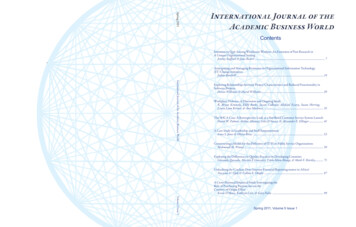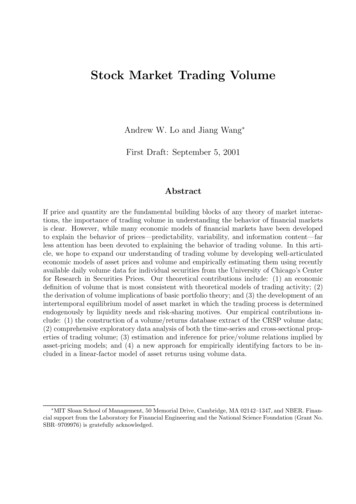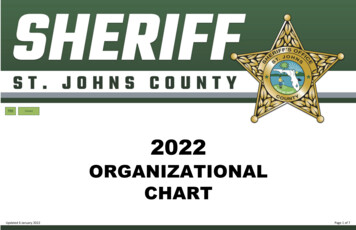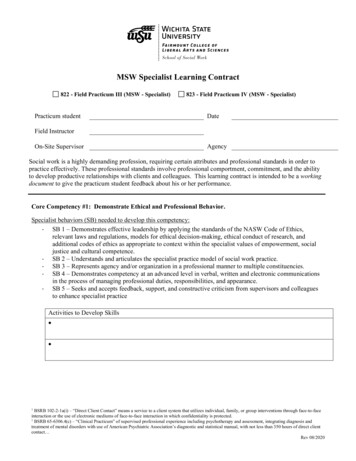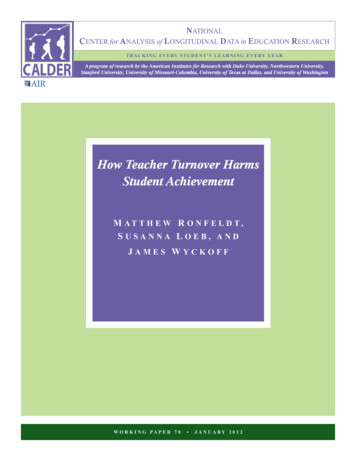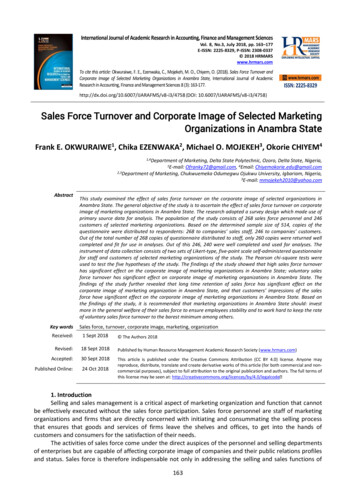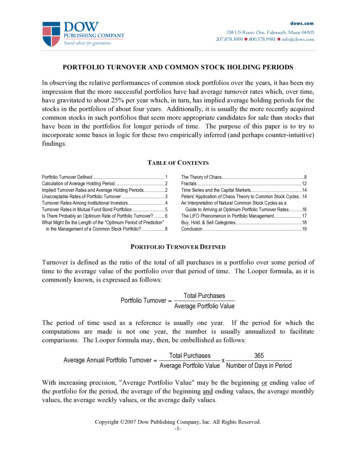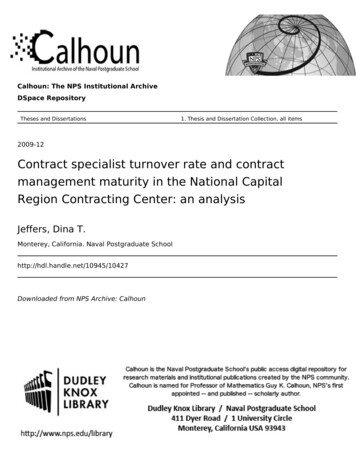
Transcription
Calhoun: The NPS Institutional ArchiveDSpace RepositoryTheses and Dissertations1. Thesis and Dissertation Collection, all items2009-12Contract specialist turnover rate and contractmanagement maturity in the National CapitalRegion Contracting Center: an analysisJeffers, Dina T.Monterey, California. Naval Postgraduate Schoolhttp://hdl.handle.net/10945/10427Downloaded from NPS Archive: Calhoun
NAVALPOSTGRADUATESCHOOLMONTEREY, CALIFORNIAJOINT APPLIED PROJECTContract Specialist Turnover Rate and Contract ManagementMaturity in the National Capital Region Contracting Center: AnAnalysisBy:Dina T. JeffersDecember 2009Advisors:Rene G. RendonGeorge A. SearsApproved for public release; distribution is unlimited
THIS PAGE INTENTIONALLY LEFT BLANK
REPORT DOCUMENTATION PAGEForm Approved OMB No. 0704-0188Public reporting burden for this collection of information is estimated to average 1 hour per response, including the time for reviewinginstruction, searching existing data sources, gathering and maintaining the data needed, and completing and reviewing the collectionof information. Send comments regarding this burden estimate or any other aspect of this collection of information, includingsuggestions for reducing this burden, to Washington headquarters Services, Directorate for Information Operations and Reports, 1215Jefferson Davis Highway, Suite 1204, Arlington, VA 22202-4302, and to the Office of Management and Budget, Paperwork ReductionProject (0704-0188) Washington DC 20503.1. AGENCY USE ONLY (Leave blank)2. REPORT DATEDecember 20093. REPORT TYPE AND DATES COVEREDJoint Applied Project4. TITLE AND SUBTITLE5. FUNDING NUMBERSContract Specialist Turnover Rate and Contract Management Maturity in theNational Capital Region Contracting Center: An Analysis6. AUTHOR(S) Dina T. Jeffers8. PERFORMING ORGANIZATION7. PERFORMING ORGANIZATION NAME(S) AND ADDRESS(ES)REPORT NUMBERNaval Postgraduate SchoolMonterey, CA 93943-50009. SPONSORING /MONITORING AGENCY NAME(S) AND ADDRESS(ES)10. SPONSORING/MONITORINGAGENCY REPORT NUMBERN/A11. SUPPLEMENTARY NOTES The views expressed in this study are those of the author and do not reflect theofficial policy or position of the Department of Defense or the U.S. Government.12a. DISTRIBUTION / AVAILABILITY STATEMENT12b. DISTRIBUTION CODEApproved for public release; distribution is unlimited13. ABSTRACT (maximum 200 words)The U.S. Army Contracting Command National Capital Region Contracting Center (ACC-NCRCC orNCRCC) incorporates the Army’s Contracting Center of Excellence (CCE) and the U.S. Army InformationTechnology, E-Commerce and Commercial Contracting Center (ITEC4). CCE provides contractingsupport to the Army Secretariat and the Army Staff. ITEC4 provides worldwide information technologycontracting support and procures enterprise information technology support and equipment for Army andDepartment of Defense (DoD) activities (ACC, 2009, n.p.). The purpose of this research is to measure theturnover rate of the NCRCC’s contract specialists, assess its contract management capability processmaturity and determine if a relationship exists between the two.Research for this study consisted of collecting NCRCC contract specialist statistical data and qualificationsfrom NCRCC Human Resources (HR) for the 12-month period observed and using it to calculate theturnover rate. The research also included deploying survey questions to the NCRCC workforce to assessits contract management process capability maturity.14. SUBJECT TERMS Turnover, Contract Management, Contract ManagementMaturity Model, Procurement Planning, Solicitation Planning, Solicitation, SourceSelection, Contract Administration, Contract Closeout, National Capital RegionContracting Center17. SECURITYCLASSIFICATION OFREPORTUnclassified18. SECURITYCLASSIFICATION OF THISPAGEUnclassifiedNSN 7540-01-280-550019. SECURITYCLASSIFICATION OFABSTRACTUnclassified15. NUMBER OFPAGES8716. PRICE CODE20. LIMITATION OFABSTRACTUUStandard Form 298 (Rev. 2-89)Prescribed by ANSI Std. 23918i
THIS PAGE INTENTIONALLY LEFT BLANKii
Approved for public release; distribution is unlimitedCONTRACT SPECIALIST TURNOVER RATE AND CONTRACTMANAGEMENT MATURITY IN THE NATIONAL CAPITAL REGIONCONTRACTING CENTER: AN ANALYSISDina T. JeffersCivilian, United States ArmySubmitted in partial fulfillment of the requirements for the degree ofMASTER OF SCIENCE IN CONTRACT MANAGEMENTfrom theNAVAL POSTGRADUATE SCHOOLDecember 2009Authors:Dina T. JeffersApproved by:Dr. Rene G. Rendon, D.B.A., Lead AdvisorGeorge A. Sears, Support AdvisorDr. William R. Gates, DeanGraduate School of Business and Public Policyiii
THIS PAGE INTENTIONALLY LEFT BLANKiv
alRegionContracting Center (ACC-NCRCC or NCRCC) incorporates the Army’sContracting Center of Excellence (CCE) and the U.S. Army InformationTechnology, E-Commerce and Commercial Contracting Center (ITEC4). CCEprovides contracting support to the Army Secretariat and the Army Staff. ITEC4provides worldwide information technology contracting support and procuresenterprise information technology support and equipment for Army andDepartment of Defense (DoD) activities (ACC, 2009, n.p.). The purpose of thisresearch is to measure the turnover rate of the NCRCC’s contract specialists,assess its contract management capability process maturity and determine if arelationship exists between the two.Research for this study consisted of collecting NCRCC contract specialiststatistical data and qualifications from NCRCC Human Resources (HR) for the12-month period observed and using it to calculate the turnover rate.Theresearch also included deploying survey questions to the NCRCC workforce toassess its contract management process capability maturity.v
THIS PAGE INTENTIONALLY LEFT BLANKvi
TABLE OF CONTENTSI.INTRODUCTION. 1A.INTRODUCTION . 1B.RESEARCH PURPOSE AND OBJECTIVES . 1C.BACKGROUND . 2D.RESEARCH METHODOLOGY . 3E.LIMITATIONS OF THE RESEARCH . 3F.RESEARCH QUESTIONS . 41.Primary Research Questions. 42.Subsidiary Research Questions. 5G.REPORT ORGANIZATION. 5H.SUMMARY. 5II.LITERATURE REVIEW . 7A.INTRODUCTION . 7B.CURRENT CONTRACTING ENVIRONMENT . 7C.EMPLOYEE TURNOVER . 9D.MEASURING TURNOVER RATE. 10E.THE COST OF TURNOVER . 11F.CONTRACT MANAGEMENT PROCESS CAPABILITY . 13G.THE PURPOSE OF MEASURING CM PROCESS MATURITY . 19H.SUMMARY. 20III.NATIONAL CAPITAL REGION CONTRACTING CENTER . 23A.INTRODUCTION . 23B.THE U.S. ARMY MATERIAL COMMAND . 23C.THE U.S. ARMY CONTRACTING COMMAND . 24D.NATIONAL CAPITAL REGION CONTRACTING CENTER . 25E.SUMMARY. IONS. 31A.INTRODUCTION . 31B.NCRCC’S EMPLOYEE TURNOVER RATE . 31C.NCRCC’S COST OF TURNOVER . ATIONS, AND CREDENTIALS. 34E.TURNOVER RECOMMENDATIONS . 37F.NCRCC’S CONTRACT MANAGEMENT PROCESS CAPABILITYMATURITY. 391.Contracting Center of Excellence . 412.Information Technology, E-Commerce and CommercialContracting Center . 42vii
G.H.V.CONTRACTMANAGEMENTPROCESSCAPABILITYMATURITY RECOMMENDATIONS. 421.Contracting Center of Excellence . 422.Information Technology, E-Commerce and CommercialContracting Center . 44SUMMARY. 44SUMMARY, CONCLUSIONS, AND AREAS FOR FURTHER RESEARCH 47A.INTRODUCTION . 47B.RESEARCH SUMMARY. 471.What is the Current Turnover Rate of ContractSpecialists in NCRCC?. 482.What is the Current Maturity Level of NCRCC’s ContractManagement Processes?. 483.Is There a Relationship Between NCRCC ContractSpecialist Turnover and the Maturity Level of itsContract Management Processes? . 484.How does the Contract Specialist Turnover Rate affectNCRCC’s Contract Specialist Average ExperienceLevel? . 485.How does NCRCC’s Contract Specialist AverageExperience Level affect its Training Requirement?. 496.How Can NCRCC Raise its Maturity Level?. 49C.RESEARCH CONCLUSIONS . 50D.AREAS FOR FURTHER RESEARCH . 52APPENDIXNCRCC CONTRACT SPECIALIST STATISTICAL DATA ANDQUALIFICATION QUESTIONS AND ANSWERS . 551.Contract Specialist Turnover Rate Statistics. . 552.Contract Specialist Qualifications. 59LIST OF REFERENCES. 61INITIAL DISTRIBUTION LIST . 67viii
LIST OF FIGURESFigure 1.Figure 2.Figure 3.Figure 4.Figure 5.Figure 6.Figure 7.Figure 8.Simplified Turnover Costing Model (From Mathis & Jackson, 2003,p. 90) . 12AMC Organizational Structure (From AMC, 2009) . 24ACC Organizational Structure (From Public Folders, 2009) . 25NCRCC Organizational Structure (From NCRCC Town HallMeeting, 2009, p. 10). 26CCE Organizational Structure (From CCE, 2009) . 27ITEC4 Organizational Structure (From Public Folders, 2009) . 28Turnover Trend Analysis (From JOLTS, 2009). 33Cost of NCRCC Turnover April 2008–March 2009 . 34ix
THIS PAGE INTENTIONALLY LEFT BLANKx
LIST OF TABLESTable 1.Table 2.Table 3.Contract Management Maturity Model (From Garrett & Rendon,2005a, p. 54) . 19NCRCC Turnover Data. 32NCRCC Contract Management Maturity Model . 41xi
THIS PAGE INTENTIONALLY LEFT BLANKxii
LIST OF ACRONYMS AND ABBREVIATIONSACC-NCRCCU.S. Army Contracting Command National Capital RegionContracting CenterACCArmy Contracting CommandACTEDSArmy Career Training & Education Development SystemAMCArmy Material CommandAT&LAcquisition, Technology and LogisticsBLSBureau of Labor StatisticsBRACBase Realignments and ClosuresCCEArmy’s Contracting Center of ExcellenceCDG/AAFCompetitive Development Group/Army AcquisitionFellowshipCMContract ManagementCMMM Contract Management Maturity Model DADepartment of the ArmyDAWIADefense Acquisition Workforce Improvement ActDoDDepartment of DefenseFARFederal Acquisition RegulationGAOUnited States Government Accountability OfficeGSGeneral ScheduleHRHuman Resources DepartmentITEC4U.S. Army Information Technology, E-Commerce andCommercial Contracting CenterJOLTSJob Openings and Labor Turnover SurveyNCRNational Capital Regionxiii
NCRCCUS Army Contracting Command National Capital RegionContracting CenterNSPSNational Security Personnel SystemOPARCOffice of the Principal Assistant Responsible for ContractingOPMU.S. Office of Personnel ManagementPARCPrincipal Assistant Responsible for ContractingPWSPerformance Work StatementSOOStatement of ObjectivesSOWStatement of Workxiv
ACKNOWLEDGMENTSThank you to Dr. Rene Rendon for providing your time and the guidance Ineeded to complete this project.Thank you to Mr. George Sears for granting me access to NCRCC.Thank you to all NCRCC employees who participated in the researchsurvey.I want to give a BIG shout out and thank you to Ms. Patricia Sprague andMs. Mary Matherly for your assistance in gathering statistical data for thisproject.Most importantly, thank you to Miss Lia Camille Jeffers and Miss JalynMaya Jeffers for your patience and understanding, tolerating my crankiness,preparing meals, running our household without me, and hanging in there withme for the last two years while I was preoccupied with schoolwork. I love yougirls! Mom is back! LOL !xv
THIS PAGE INTENTIONALLY LEFT BLANKxvi
EXECUTIVE lRegionContracting Center (ACC-NCRCC or NCRCC) incorporates the Army’sContracting Center of Excellence (CCE) and the U.S. Army InformationTechnology, E-Commerce and Commercial Contracting Center (ITEC4). CCEprovides contracting support to the Army Secretariat and the Army Staff. ITEC4provides worldwide information technology contracting support and procuresenterprise information technology support and equipment for Army andDepartment of Defense (DoD) activities (ACC, 2009, n.p.). The purpose of thisresearch is to measure the turnover rate of the NCRCC’s contract specialists,assess its contract management capability process maturity and determine if arelationship exists between the two.Research for this study consisted of collecting NCRCC contract specialiststatistical data and qualifications from NCRCC Human Resources (HR) for the12-month period observed and using it to calculate the turnover rate.Theresearch also included deploying survey questions to the NCRCC workforce toassess its contract management process capability maturity.The results of this research shows that no apparent relationship existsbetween the NCRCC contract specialist turnover rate and its contractmanagement process capability maturity. The NCRCC turnover rate is low ascompared to the entire Federal Government’s turnover rate for the periodobserved; however, NCRCC leadership should measure and track employeeturnover as well as the costs associated with it to manage its workforce andprotect its brand. Generally, NCRCC’s contract management process maturitylevel is low.CCE received an Ad-hoc maturity rating for the ProcurementPlanning, Solicitation Planning, Solicitation, Contract Administration, andContract Closeout key process areas and a Basic maturity rating for the SourceSelection key process area. ITEC4 received a Basic maturity rating for all six keyxvii
process areas.Recommendations for improving NCRCC’s maturity levelconsists of establishing and institutionalizing processes and standards,mandating its employees to use them on all contracts, initiating organization-wideCM training, developing efficiency and effectiveness metrics, and building alessons-learned and best practices database.xviii
I.A.INTRODUCTIONINTRODUCTIONThe purpose of this chapter is to present a general overview of thisresearch project. It will provide the research purpose, objectives and backgroundinformation. Next, it will describe the research methodology, the limitations of theresearch, and the primary and subsidiary research questions. It will then explainthe organization of this report and lastly, provide a chapter summary.B.RESEARCH PURPOSE AND OBJECTIVESIn this project, the author will analyze the turnover rate for NCRCCcontract specialists and assess NCRCC’s Contract Management (CM) processcapability maturity level using the Contract Management Maturity Model (CMMM ) (Garrett & Rendon, 2005a, p. 49). The CMMM is an approach toassessing process capability maturity by focusing on six key process areas:Procurement Planning, Solicitation Planning, Solicitation, Source Selection,Contract Administration, and Contract Closeout (Garrett & Rendon, 2005a, p.49).Based on this analysis, the author will then attempt to determine if arelationship exists between the NCRCC’s contract specialist turnover rate and itsCM process capability maturity.The author expects that if any relationship exists, the NCRCC turnoverrate will impact its maturity level and not the other way around. It is unlikely thatthe reverse would exist. Lastly, the author will identify possible solutions andrecommend approaches to improve NCRCC’s organizational capability based onthe analysis.The results of this research will assist NCRCC leadership inidentifying areas that may need additional emphasis such as personnel,resources, and training.1
C.BACKGROUNDSince the end of the Cold War, DoD significantly reduced the size of itscivilian contracting workforce through downsizing, base realignments andclosures (BRACs), and competitive sourcing initiatives.The Departmentassumed that after the Cold War ended the contracting workload would decrease(GAO-04-753, 2004, p. 7). DoD did not anticipate that in addition to plannedworkforce reductions that the workforce would be further reduced as the babyboom generation began to retire. Experts estimate that by the year 2012, theacquisition workforce will reduce by half due to a retirement eligible workforce(SARA, 2007, p. 3). This has created an acquisition workforce shortage at a timewhen DoD contracts have increased in both complexity and volume (Gansler,2007, p. 14) and DoD needs experienced CM personnel to manage its workload.In NCRCC, the workforce shortage is further complicated because it isgeographically located in the National Capital Region (NCR), just outside of thenation’s capital where there are many defense and civilian Governmentcontracting agencies as well as industry contracting organizations.Theseorganizations compete for skilled contract specialists thus creating “a war fortalent” (Mathis & Jackson, 2003, p. 80) and contracting professionals are enticedto climb the career ladder by ‘job-hopping’ and ‘job shopping’ (Harrison, R., 2008,p. 49).The current ‘buyer’s market’ for contract specialists has led to anincrease in the turnover rate for these employees within Government andindustry contracting organizations. A high turnover rate in the NCRCC couldimpede its ability to complete its mission successfully and could negativelyimpact the NCRCC brand, which should support its vision:“To be the bestcontracting service experience” (NCRCC Town Hall Meeting, 2009, p. 4).A high turnover rate can lead to an unstable workforce that is likely tohave difficulty managing mature contract processes. This is because unstableorganizations endure new employees consistently going through a processlearning curve so that even if an organization has standardized processes in2
place, the individuals responsible for working within them may have difficultyputting them into practice. A stable workforce is more capable of implementingmature, standardized processes and continuously improving them until theseprocesses become mature.If NCRCC wishes to protect its brand, it must maintain a competitiveadvantage over other contracting organizations within NCR, in terms ofsuccessful performance.It requires “a systematic approach to assessingeffectiveness and competence” (Garrett & Rendon, 2005a, p. 49). The ContractManagement Maturity Model (CMMM ) is one useful tool for conducting suchan assessment. Applying the CMMM will allow NCRCC to determine its CMprocess capability maturity for the six key process areas, which will “serve as thefoundation for ongoing discussion and further development within” thecontracting center (Garrett, 2007, p. 214).D.RESEARCH METHODOLOGYResearch for this project consists of collecting NCRCC contract specialistturnover rate statistical data and qualifications from NCRCC Human Resources(HR) for one 12-month period, April 2008 through March 2009, and using it tocalculate the turnover rate.The research will be limited to NCRCCnonsupervisory contract specialists, grade GS-12 and above. These contractspecialists work ‘where the rubber meets the road’ and should be performing atjourneyman or advanced levels. The research also includes deploying surveyquestions to the NCRCC workforce to assess its CM process capability maturity.The author will look for a relationship between NCRCC’s turnover rate and its CMprocess capability maturity level, report the findings and offer recommendationsfor improvement.E.LIMITATIONS OF THE RESEARCHTurnover rate calculations used in this research project are not exact for avariety of reasons. First, the author will use a modified version of the turnover3
rate formula described in Chapter II to calculate the turnover rate. The formuladescribed in Chapter II calculates turnover using mid-month data; however, thiswas not available to the author who therefore, calculated NCRCC’s turnover rateusing end-of-month data.Further, the total number of employees used tocalculate the turnover rate includes employees located at Fort Huachuca, AZ.One cannot attribute the turnover of these employees to market conditions inNCR. Lastly, the turnover analysis in this project does not distinguish betweendysfunctional and controllable turnover from other turnover types, however,NCRCC stakeholders should consider this when using this research.The CM process maturity assessment may also be slightly limited. Onereason is that the author obtained CM maturity data from an online survey thatNCRCC contract specialists completed anonymously. Subsequently, the surveyresults are only as accurate as the data that survey participants entered. Finally,the research only invited NCRCC nonsupervisory contract specialists grade GS12 and above to participate in the survey since this group is the focus of theresearch. Approximately 204 employees were eligible to participate and 137surveys were completed (20 for CCE and 117 for ITEC4) for a response rate of67%. Larger or smaller sample sizes may result in different findings.F.RESEARCH QUESTIONSThis project addresses two primary and four subsidiary researchquestions:1.Primary Research Questionsa.What is the current turnover rate of contract specialists in NCRCC?b.Whatisthecurrentmaturitymanagement processes?4levelofNCRCC’scontract
2.Subsidiary Research Questionsa.Is there a relationship between NCRCC contract specialist turnoverand the maturity level of its contract management processes?b.How does the contract specialist turnover rate affect NCRCC’scontract specialist average experience level?c.How does NCRCC’s contract specialist average experience levelaffect its training requirement?d.G.How can NCRCC raise its CM process maturity level?REPORT ORGANIZATIONThe author organized this report into five chapters.Chapter I, theIntroduction, discusses the purpose and objectives of the study, providesbackground information, explains the research methodology, the researchlimitations, sets forth the primary and secondary research questions, andexplains the organization of this report.Chapter II, the Literature Review,discusses the current contracting environment, employee turnover, the ContractManagement Maturity Model (CMMM), and their impact or contractingorganizations.Chapter III describes the National Capital Region ContractingCenter, its major and subordinate commands and their missions, organizationalstructures, workforce makeup, and explains why NCRCC is suitable for thisstudy. Chapter IV provides the results of the NCRCC turnover analysis and theresults of the CM process maturity analysis. Chapter V presents the author’sresearch conclusions, summarize the research findings, and discuss possibleareas for further research.H.SUMMARYDoD is facing an acquisition workforce shortage at a time when itscontract requirements have become more complex and voluminous (Gansler,2007, p. 14).Additionally, NCRCC must compete with other contracting5
organizations for CM personnel in NCR. If NCRCC’s contract specialist turnoverrate is too high, and its workforce becomes unstable, its brand may suffer. Oneway to protect the NCRCC brand is to assess its CM process capability and usethe assessment to identify process improvement opportunities as recommendedin this research project.In this chapter, the author discussed the research purpose and objectives,described background information, and the research methodology.Next, theauthor presented the limitations of the research, research questions, and thereport organization.The next chapter will provide a literature review onemployee turnover and CM process maturity.6
II.A.LITERATURE REVIEWINTRODUCTIONThis chapter describes the current government contracting environmentand explains why it is important for contracting organizations, particularly those inNCR, to assess its employee turnover rate and CM process maturity level. Itdescribes different turnover types, explains how to measure it and what turnovercosts an organization. Next, this chapter explains why analyzing CM processcapability is important to NCRCC, describes the purpose of assessing processcapability maturity, presents the Contract Management Maturity Model (CMMM), and explains how and why CM process maturity is measured.B.CURRENT CONTRACTING ENVIRONMENTGovernment contracting processes are under tremendous public scrutiny.Media focus on Federal contracts in Iraq such as the State Department’s privatesecurity contract with Blackwater Worldwide (Dreazen, 2009) and the Army’sLogistics Civil Augmentation Program (LOGCAP) contract with KBR Halliburton(Castelli, 2009) have drawn public awareness to Federal contracting processes.This awareness increased after the passage of the American Recoveryand Reinvestment Act of 2009 (Recovery Act, 2009), as United States tax payersdemanded to know how the Government would spend their tax dollars tostimulate the economy.The President of the United States’ March 4, 2009memorandum on the subject of government contracting focuses on competition,contract type, and outsourcing initiatives (Government Contracting, 2009). Inaddition, the Federal Government established a website that provides Federalcontract information to the American public (USAspending.com, 2009), a result ofthe President’s push for transparency (Transparency, 2009).7
According to the Report of the Acquisition Advisory Panel to the Office ofFederal Procurement Policy and the U.S. Congress, “The demands on the[contracting] workforce, both in terms of the complexity and nature of what isbought, have markedly increased since the 1980s” (SARA, 2007, p. 18). TheCommission on Army Acquisition and Program Management in ExpeditionaryOperations states, “The Army’s acquisition workforce is not adequately staffed,trained, structured, or empowered to meet the Army needs of the 21st Centurydeployed warfighters” (Gansler, 2007, p. 2).The Gansler Commission determined that:Contract management is the essential post-award contractingfunction to ensure mission accomplishment, and to ensure that theGovernment obtains the required work on time and at the qualitylevel called for by the contract. It is also an important control overfraud, waste, and abuse. (Gansler, 2007, p. 27)The United States Government Accountability Office (GAO) has identifiedDoD Contract Management as “high risk” in its biennial report to Congress everyyear since 1992. GAO’s High-Risk Series lists government operations that arevulnerable to fraud, waste, abuse, and mismanagement or the operations ,efficiency,oreffectiveness challenges (GAO-09-271, 2009). One of the reasons that GAOincluded DoD Contract Management on its list is the department’s CM personnelshortage (GAO-09-271, 2009, p. 73). GAO explains that:Properly managing the acquisition of goods and services requires aworkforce with the right skills and capabilities. DOD reports it hasidentified the competencies needed by its contracting officers butDOD officials acknowledged that more needs to be done to closeskill gaps and to expand efforts to those who perform oversight orother key acquisition roles. (GAO-09-271, 2009, p. 73)Ken Krieg, the former Under Secretary of Defense for Acquisition,Technology and Logistics (AT&L
14. SUBJECT TERMS Turnover, Contract Management, Contract Management Maturity Model, Procurement Planning, Solicitation Planning, Solicitation, Source Selection, Contract Administration, Contract Closeout, National Capital Region Contracting Center 16. PRICE CODE 17. SECURITY CLASSIFICATION OF REPORT Unclassified 18. SECURITY CLASSIFICATION OF .
